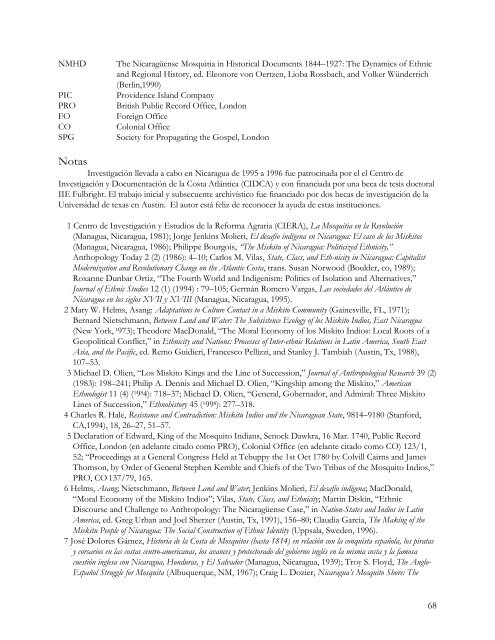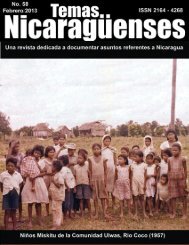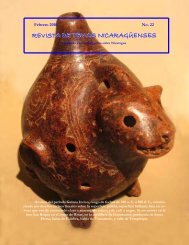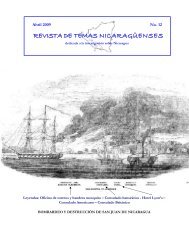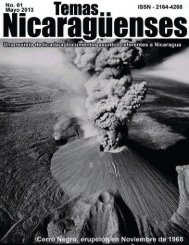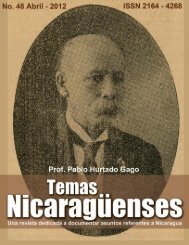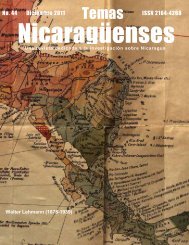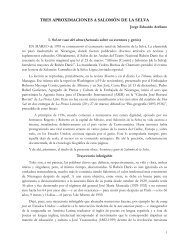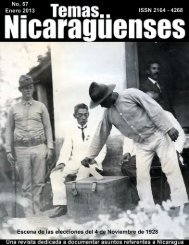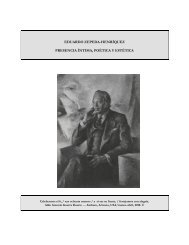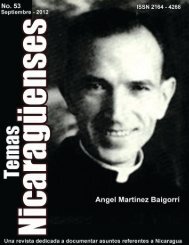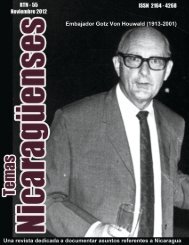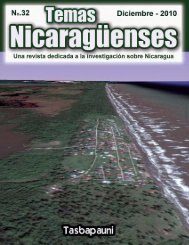21 - Revista de Temas Nicaragüenses
21 - Revista de Temas Nicaragüenses
21 - Revista de Temas Nicaragüenses
You also want an ePaper? Increase the reach of your titles
YUMPU automatically turns print PDFs into web optimized ePapers that Google loves.
NMHD The Nicaragüense Mosquitia in Historical Documents 1844–1927: The Dynamics of Ethnic<br />
and Regional History, ed. Eleonore von Oertzen, Lioba Rossbach, and Volker Wün<strong>de</strong>rrich<br />
(Berlin,1990)<br />
PIC Provi<strong>de</strong>nce Island Company<br />
PRO British Public Record Office, London<br />
FO Foreign Office<br />
CO Colonial Office<br />
SPG Society for Propagating the Gospel, London<br />
Notas Investigación llevada a cabo en Nicaragua <strong>de</strong> 1995 a 1996 fue patrocinada por el el Centro <strong>de</strong><br />
Investigación y Documentación <strong>de</strong> la Costa Atlántica (CIDCA) y con financiada por una beca <strong>de</strong> tesis doctoral<br />
IIE Fulbright. El trabajo inicial y subsecuente archivístico fue financiado por dos becas <strong>de</strong> investigación <strong>de</strong> la<br />
Universidad <strong>de</strong> texas en Austin. El autor está feliz <strong>de</strong> reconocer la ayuda <strong>de</strong> estas instituciones.<br />
1 Centro <strong>de</strong> Investigación y Estudios <strong>de</strong> la Reforma Agraria (CIERA), La Mosquitia en la Revolución<br />
(Managua, Nicaragua, 1981); Jorge Jenkins Molieri, El <strong>de</strong>safío indígena en Nicaragua: El caso <strong>de</strong> los Miskitos<br />
(Managua, Nicaragua, 1986); Philippe Bourgois, “The Miskitu of Nicaragua: Politicized Ethnicity,”<br />
Anthopology Today 2 (2) (1986): 4–10; Carlos M. Vilas, State, Class, and Eth-nicity in Nicaragua: Capitalist<br />
Mo<strong>de</strong>rnization and Revolutionary Change on the Atlantic Costa, trans. Susan Norwood (Boul<strong>de</strong>r, co, 1989);<br />
Roxanne Dunbar Ortiz, “The Fourth World and Indigenism: Politics of Isolation and Alternatives,”<br />
Journal of Ethnic Studies 12 (1) (1994) : 79–105; Germán Romero Vargas, Las socieda<strong>de</strong>s <strong>de</strong>l Atlántico <strong>de</strong><br />
Nicaragua en los siglos XVII y XVIII (Managua, Nicaragua, 1995).<br />
2 Mary W. Helms, Asang: Adaptations to Culture Contact in a Miskito Community (Gainesville, FL, 1971);<br />
Bernard Nietschmann, Between Land and Water: The Subsistence Ecology of los Miskito Indios, East Nicaragua<br />
(New York, 1973); Theodore MacDonald, “The Moral Economy of los Miskito Indios: Local Roots of a<br />
Geopolitical Conflict,” in Ethnicity and Nations: Processes of Inter-ethnic Relations in Latin America, South East<br />
Asia, and the Pacific, ed. Remo Guidieri, Francesco Pellizzi, and Stanley J. Tambiah (Austin, Tx, 1988),<br />
107–53.<br />
3 Michael D. Olien, “Los Miskito Kings and the Line of Succession,” Journal of Anthropological Research 39 (2)<br />
(1983): 198–241; Philip A. Dennis and Michael D. Olien, “Kingship among the Miskito,” American<br />
Ethnologist 11 (4) ( 19 84): 718–37; Michael D. Olien, “General, Gobernador, and Admiral: Three Miskito<br />
Lines of Succession,” Ethnohistory 45 ( 199 8): 277–318.<br />
4 Charles R. Hale, Resistance and Contradiction: Miskitu Indios and the Nicaraguan State, 9814–9180 (Stanford,<br />
CA,1994), 18, 26–27, 51–57.<br />
5 Declaration of Edward, King of the Mosquito Indians, Senock Dawkra, 16 Mar. 1740, Public Record<br />
Office, London (en a<strong>de</strong>lante citado como PRO), Colonial Office (en a<strong>de</strong>lante citado como CO) 123/1,<br />
52; “Proceedings at a General Congress Held at Tebuppy the 1st Oct 1780 by Colvill Cairns and James<br />
Thomson, by Or<strong>de</strong>r of General Stephen Kemble and Chiefs of the Two Tribus of the Mosquito Indios,”<br />
PRO, CO 137/79, 165.<br />
6 Helms, Asang; Nietschmann, Between Land and Water; Jenkins Molieri, El <strong>de</strong>safío indígena; MacDonald,<br />
“Moral Economy of the Miskito Indios”; Vilas, State, Class, and Ethnicity; Martin Diskin, “Ethnic<br />
Discourse and Challenge to Anthropology: The Nicaragüense Case,” in Nation-States and Indios in Latin<br />
America, ed. Greg Urban and Joel Sherzer (Austin, Tx, 1991), 156–80; Claudia Garcia, The Making of the<br />
Miskitu People of Nicaragua: The Social Construction of Ethnic I<strong>de</strong>ntity (Uppsala, Swe<strong>de</strong>n, 1996).<br />
7 José Dolores Gámez, Historia <strong>de</strong> la Costa <strong>de</strong> Mosquitos (hasta 1814) en relación con la conquista española, los piratas<br />
y corsarios en las costas centro-americanas, los avances y protectorado <strong>de</strong>l gobierno inglés en la misma costa y la famosa<br />
cuestión inglesa con Nicaragua, Honduras, y El Salvador (Managua, Nicaragua, 1939); Troy S. Floyd, The Anglo-<br />
Español Struggle for Mosquita (Albuquerque, NM, 1967); Craig L. Dozier, Nicaragua’s Mosquito Shore: The<br />
68


